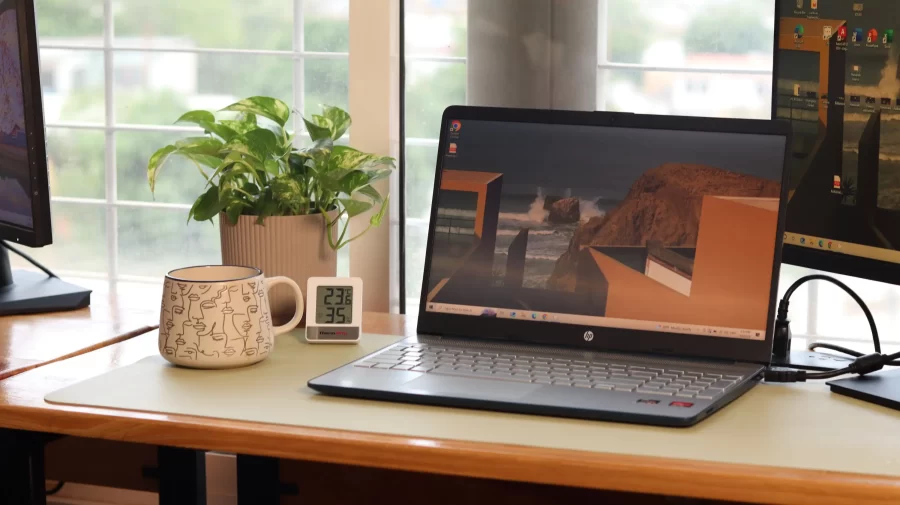Have you ever heard of asynchronous work? It’s becoming a popular trend in the work world, so I thought I’d give you a quick introduction! In a nutshell, asynchronous work is all about flexibility. Instead of working a set schedule, with asynchronous working, employees have the freedom to complete tasks on their own time, as long as deadlines are met.
This type of work allows for a better work-life balance and can increase productivity. Plus, with the rise of remote work, asynchronous work has become even more prevalent. So, let’s dive in and explore this growing trend!

Over the years, we have seen a significant shift from traditional office settings to more flexible work environments. With advancements in technology and the growing need for work-life balance, many businesses are now opting for remote work, flexible schedules, and coworking spaces.
This shift has allowed employees to work from anywhere in the world, providing them with the freedom to balance their personal and professional lives. Additionally, it has also helped businesses to reduce overhead costs and increase employee productivity. With the rise of flexible work arrangements, it’s safe to say that traditional office settings may soon become a thing of the past.
What Is Async Work?
Async work, or asynchronous work, refers to a work style where tasks are completed on flexible schedules rather than in real-time collaboration.
Unlike traditional sync work an asynchronous company that requires immediate responses or participation during specific hours, async work allows individuals to tackle their tasks when it suits them best, as long as they meet predetermined deadlines.
Synchronous asynchronous communication, on the other hand, involves real-time interactions that occur simultaneously—such as meetings, phone calls, or live chats—where immediate feedback or collaboration is essential.
Conversely, async communication relies on methods that do not require an immediate response, such as emails, instant messages, recorded video updates, or message board postings, allowing for more thoughtful responses and flexibility during working hours.
This distinction highlights a fundamental shift in the approach to collaboration and communication within the modern workplace, emphasizing efficiency, autonomy, and a better work-life balance.
The Growing Popularity of Async Work
In recent years, there has been a global shift towards remote work due to technological advancements and changing attitudes towards work-life balance. The COVID-19 pandemic has further accelerated this trend, with many companies adopting remote work policies.
Remote work offers numerous benefits such as increased flexibility, reduced commuting time, and improved productivity. However, it also presents challenges such as loneliness, communication barriers, mental health,, and lack of access to necessary resources.
To succeed in this new work environment, individuals and organizations need to be adaptable and open to change and continuously seek innovative ways to collaborate and connect.
The Pandemic Had A Huge Impact On Work Practices
The COVID-19 pandemic has had a profound impact on the way we work. One of the most significant changes has been the accelerated adoption of asynchronous work practices. With remote work becoming the norm, companies have had to find new ways to collaborate and communicate with their employees.
Asynchronous work allows team members to work at their own pace and on their own schedule, which has proven to be a more flexible and efficient way of working. The pandemic has forced companies to embrace this approach, and it is likely that asynchronous work practices will continue to be a vital part of the modern workplace even after the pandemic is over.
Benefits of Async Work for Businesses
Increased Productivity

One of the coolest things about async work is how it cuts down on those pesky interruptions. You know, those “Hey, got a minute?” moments that somehow turn into an hour. Without the constant pinging of notifications, video calls, and impromptu meetings, you’re free to really zone in on what you’re doing.
This isn’t just about getting more done (though that’s a nice bonus); it’s about the quality of what you produce. When you have the space to dig deep into a project, to do deep work really think through the problems, and craft thoughtful solutions, the end result is just better.
It’s like giving a gourmet chef the quiet and time they need to create a masterpiece meal, instead of expecting them to whip up something amazing during the dinner rush.
Enhanced Work-Life Balance
Async work is basically the superhero of work-life balance. Imagine being able to drop your kids off at school without sprinting back for an early meeting, or actually making it to that mid-morning yoga class because you’ve decided when your workday starts.
It’s about working when you’re at your peak, whether that’s 5 a.m. for the early birds or 11 p.m. for the night owls. And it’s not just about the where and when; it’s feeling that your time outside of work is genuinely yours, leading to a happier, more satisfied you.
This isn’t just about fitting work into your life; it’s about creating a life where work plays its part, not the lead role.
Access To A Broader Talent Pool
And here’s where it gets even more exciting – with async work, companies are no longer stuck playing the talent lotto in their own backyard. They’re free to scout the globe for the best of the best, unhindered by zip codes and time zones.
It’s like the entire world becomes your recruitment pool. Picture this: your marketing team is brainstorming in New York, while your lead designer adds their genius from a cozy café in Paris, and your coder is debugging away on a beach in Thailand.
This global talent smorgasbord not only brings diverse perspectives into your projects but also allows for around-the-clock productivity. It’s a win-win; businesses get the cream of the crop, and talent gets to work where they’re happiest.
Tools and Technologies Enabling Async Collaboration

The linchpin to mastering async collaboration lies in harnessing the power of cutting-edge project management platforms. Tools like Slack, Trello, and Asana have become game-changers, breaking down the barriers of traditional work hours and office spaces. These platforms are designed to streamline communication, project management platform and tracking, and workflow management, enabling teams spread across different continents to work together effectively.
They offer features such as task assignment, progress tracking, and integrated instant messaging channels and systems, ensuring that every team member stays in the loop and can contribute on their own schedule. This tech stack is not just about keeping projects on track; it’s about building a flexible and inclusive work environment that embraces the diversity of global talent and asynchronous work ethics.
Communication Tools Designed For Async Interaction
Communication tools designed for asynchronous interaction between remote teams are pivotal in bridging the time zone divide, enabling team members to share ideas, feedback, and updates in their own time. Platforms such as Slack and Microsoft Teams facilitate this by allowing for structured thread conversations, direct messaging, and the creation of specific channels dedicated to distinct projects or topics.
This ensures that important discussions are not buried in an overflowing inbox, making it easier for team members to catch up and contribute thoughtfully at their convenience. Additionally, the integration of file-sharing and collaboration tools within these platforms enables seamless exchange of documents, designs, and code, further enhancing the efficiency of remote teamwork.
File Sharing Technologies To Help Remote Collaboration
In the realm of remote work, the ability to share documents and files without a hitch is nothing short of magic. Imagine seamlessly passing the virtual baton in the form of project files, presentation decks, or design mockups, all without the need for cumbersome email attachments.
That’s where cloud-based services like Google Drive, Dropbox, and OneDrive steal the show. These platforms are the superheroes of file sharing, enabling team members to upload, share, and collaborate on documents in real-time.
No more version control nightmares or “Oops, I forgot to attach the file” moments. Just smooth sailing in the digital workspace, keeping everyone on the same page (literally and figuratively), regardless of where they are in the world.
Challenges and Pitfalls of Async Work
While the async work model sings many praises, it’s not without its hurdles and hiccups. Ever had that moment where you’re waiting on a piece of crucial feedback, but your colleague is halfway across the world asleep? Yep, that’s one of the common challenges – time zone differences can lead to delays in responses, putting a damper on project timelines.
Then there’s the classic game of “digital ping-pong,” where messages can get lost in translation due to the lack of real-time communication and immediate back-and-forth, leading to misunderstandings or the need for clarity that stalls progress.
And of course, there’s the challenge of keeping everyone in the loop; when updates fly through different channels, it’s all too easy for someone to miss out, causing communication breakdowns that can sideline a project’s momentum.
It’s a tricky balance, but with the right strategies and the right tools used, these pitfalls can be navigated and overcome.
How To Overcome Async Work Challenges

Effective strategies to mitigate the challenges of asynchronous work begin with establishing clear guidelines and expectations around your communication practices. Setting up a comprehensive communication protocol, which includes regular check-ins, update schedules, and response timeframes can significantly reduce delays and misunderstandings.
Additionally, leveraging the right tech stack is crucial; tools like Slack for instant messaging, Trello or Asana for project management, and Zoom for occasional asynchronous and synchronous work and meetings ensure that information flows smoothly across different time zones and teams.
By integrating these tools into the daily workflow of asynchronous workers, teams can maintain momentum, streamline collaboration, and keep everyone aligned, thus overcoming the inherent obstacles of the asynchronous work model.
The Future of Async Work
The future of asynchronous collaboration at work is poised to evolve further, driven by advances in technology and changing workforce attitudes towards flexibility and work-life balance. We are likely to see a surge in the adoption of AI and machine learning tools designed to streamline async communication, making it even more efficient and reducing the friction points that currently exist.
Furthermore, as organizations become more comfortable with remote workers and hybrid work models, the async work approach could become a staple, reshaping traditional office hours and work structures.
This shift will require a reimagining of leadership and management practices to support a culture where trust, autonomy, and results are prioritized over physical presence and conventional schedules.
The implications for the business world are profound, offering the potential for higher productivity, greater employee satisfaction, and access to a global talent pool, ultimately leading to innovative work practices that could redefine the very nature of work in the 21st century.
Should Businesses Integrate Async And Hybrid Work Models?
In the grand tapestry of the work world, businesses are increasingly recognizing the myriad benefits of intertwining async and hybrid work models into their operational weave. Think about it—marrying the flexibility of working asynchronously with the dynamic interaction of hybrid setups could very well be the next evolution in crafting work environments that resonate with the needs and lifestyles of modern employees.
Imagine a workplace where you’re evaluated on the outcomes of your efforts rather than the hours you’re glued to a desk; where meetings are exceptions, not the rule, and where work-life balance isn’t just a buzzword but a tangible reality.
As companies continue nudging the boundaries of conventional work arrangements, they’re not just shaking up the status quo; they’re setting the stage for a future where work molds around life, not the other way around.
Async Work Is Here To Stay

To encapsulate, this blog post underscores the seismic shift towards async and hybrid work models, highlighting how they are revolutionizing traditional office norms. The essence is to foster an environment where trust and autonomy are paramount, aligning work with contemporary lifestyles and preferences.
By integrating these models, businesses stand to gain from enhanced productivity, employee satisfaction, and access to a global talent pool. This paradigm shift not merely challenges the status quo but promises a future where the architecture of work is fundamentally redefined to prioritize flexibility, outcome-based evaluations, and a harmonious work-life balance.
Enjoy All The Benefits of Async Work
The benefits of asynchronous work cannot be overstated, notably in its capacity to transform business operations and employee experiences. By prioritizing productivity over physical presence, companies can unlock unprecedented levels of efficiency and employee satisfaction.
This approach not only allows for more flexible management of time, accommodating varied work rhythms and multiple time zones but also fosters a culture where the quality of output prevails over the number of hours logged. Furthermore, the potential of async work to reshape traditional business models is immense.
It opens doors to a diversified talent pool untethered by geographical limitations and paves the way for more inclusive and adaptable work environments. In summary, the adoption of asynchronous work practices promises a future where companies thrive on innovation, flexibility, and a deep-rooted respect for individual work preferences and life commitments.
Imagine the possibilities if your business embraced the async work model. Think about it – your team is working when they’re at their peak creativity and productivity, not just when the clock says it’s time to work.
By adopting this approach, you’d be breaking free from the conventional 9-to-5, opening up a world where work fits around life, not the other way around. This isn’t just about offering flexibility; it’s about tapping into a global talent pool, driving innovation, and fostering a culture that values output over hours.
What could this mean for your business? Higher satisfaction, lower turnover, and, quite possibly, a competitive edge in your industry. The future of work is flexible, inclusive, and powered by trust. Why not lead the way?
See more articles by Andrea Corona.





